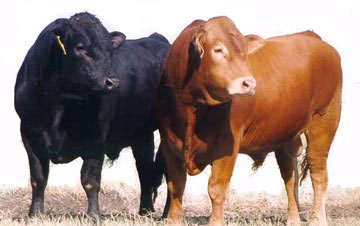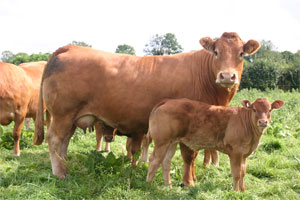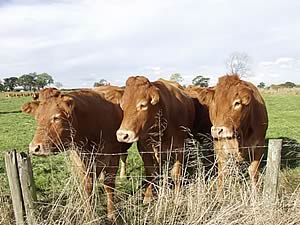
Limousin cattle are a genetic source of larger weaning weights and muscle mass while maintaining relatively low birth weights. Limousins are known for their muscular build, feed efficiency, ease of management and comparable calving ease to other breeds. Limousin cattle produce the leaner cuts of beef that have become a staple of the modern market.
Limousin cattle have a golden-brown coloration. Other coloration, such as black, has been developed through cross-breeding with other breeds of cattle. In addition to altering natural coloration other traits, such as polled (a genetic lack of horns), have been introduced through cross breeding.
US cattle producers consider Limousin cows to be low maintenance and they have the ability to feed over a wide range of resources so are good for tough environments.
From the Oklahoma State University Breeds of Livestock website:
“The history of Limousin cattle may very well be as old as the European continent itself. Cattle found in cave drawings estimated to be 20,000 years old in the Lascaux Cave near Montignac, France, have a striking resemblance to today’s Limousin.
“These golden-red cattle are native to the south central part of France in the regions of Limousin and Marche. The terrain of the homeland has been described as rugged and rolling with rocky soil and a harsh climate. Consequently, the growing of field crops was very difficult at best and emphasis was placed on animal agriculture. Limousin cattle, as a result of their environment, evolved into a breed of unusual sturdiness, health and adaptability. This lack of natural resources also enabled the region to remain relatively isolated and the farmers free to develop their cattle with little outside genetic interference.
 “During these early times of animal power, Limousin gained a well-earned reputation as work animals in addition to their beef qualities. Rene Lafarge reported in 1698, “Limousin oxen were universally renown and esteemed both as beasts of burden and beef cattle.” At the end of their work life, these animals were then fattened for slaughter.
“During these early times of animal power, Limousin gained a well-earned reputation as work animals in addition to their beef qualities. Rene Lafarge reported in 1698, “Limousin oxen were universally renown and esteemed both as beasts of burden and beef cattle.” At the end of their work life, these animals were then fattened for slaughter.
“Traditionally, French cattle were kept in a confinement or semi-confinement situation. However, Limousin cattle spent the majority of their time outdoors in the harsh climate of the region. This was a source of great pride to the breeders. The cows calved year round, outdoors, to bring in a regular source of income and the heifers were bred to calve at three years of age. In the winter, the entire herd was outside and whatever the season, the cattle were handled on a daily basis.
“As the breed developed in France, cattlemen in North America were looking to Europe to improve their native beef cattle here in the United States. In the late 1800s, English breeds such as the Hereford, Shorthorn and Angus were imported and crossed on native cattle, most of them of Spanish background. In the early 1900s Charolais were imported into Cuba and Mexico and were first introduced into the United States in the early 1930s.
 “The acceptance of Charolais, combined with the use of crossbreeding as a tool to increase beef production, lead to the investigation of many other European breeds, including Limousin, by North American cattlemen. One of the first exposures in this country concerning Limousin cattle was in the early 1960s in an issue of the Western Livestock Journal when a Canadian wrote of his impressions after returning from a trip to France. As more cattlemen traveled toEurope, they came back talking about an impressive “new” beef breed they had seen…Limousin.
“The acceptance of Charolais, combined with the use of crossbreeding as a tool to increase beef production, lead to the investigation of many other European breeds, including Limousin, by North American cattlemen. One of the first exposures in this country concerning Limousin cattle was in the early 1960s in an issue of the Western Livestock Journal when a Canadian wrote of his impressions after returning from a trip to France. As more cattlemen traveled toEurope, they came back talking about an impressive “new” beef breed they had seen…Limousin.
“The first Limousin bulls imported permanently into the United States did not arrive until the fall of 1971. Until this time, the Canadian government had not permitted any Limousin bulls to leave the country except for short periods for exhibition purposes, and then only if the owners posted a large bond that was refunded when the animal returned to Canada. The first U.S. import, Kansas Colonel, was born and raised in Canada and was imported by Bob Haag of Topeka, Kansas, for a group of Kansas Limousin breeders.”
You can learn more at the breed association North American Limousin Foundation which is located in Centennial, Colorado. Bob Millerberg is the current President.
If you have problems seeing the video below click HERE.
youtube::fLHal_m-TkA::
